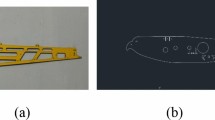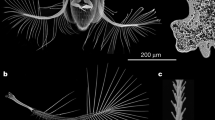Abstract
We describe the design of four ornithopters ranging in wing span from 10 cm to 40 cm, and in weight from 5 g to 45 g. The controllability and power supply are two major considerations, so we compare the efficiency and characteristics between different types of subsystems such as gearbox and tail shape. Our current ornithopter is radio-controlled with inbuilt visual sensing and capable of takeoff and landing. We also concentrate on its wing efficiency based on design inspired by a real insect wing and consider that aspects of insect flight such as delayed stall and wake capture are essential at such small size. Most importantly, the advance ratio, controlled either by enlarging the wing beat amplitude or raising the wing beat frequency, is the most significant factor in an ornithopter which mimics an insect.
Similar content being viewed by others
References
Dickinson M H, Lehmann F O, Sane S P. Wing rotation and the aerodynamic basis of insect flight. Science, 1999, 284, 1954–1960.
Bandyopadhyay P R. Trends in biorobotic autonomous undersea vehicles. IEEE Journal of Oceanic Engineering, 2005, 30, 109–139.
Pennycuick C J. The mechanics of bird migration. Ibis, 1969, 111, 525–556.
Greenewalt C H. Dimensional relationships for flying animals. Smithsonian Miscellaneous Collections, 1962, 144, 1–46.
Azuma A. The Biokinetics of Flying and Swimming, Springer, Tokyo, 1992.
Ho S, Nassef H, Pornsinsirirak N, Tai Y C, Ho C M. Unsteady aerodynamics and flow control for flapping wing flyers. Progress in Aerospace Sciences, 2003, 39, 635–681.
Pornsin-Sirirak T N, Lee S W, Nassef H, Grasmeyer J, Tai Y C, Ho C M, Keennon M. MEMS technology for a battery-powered ornithopter. The 13th IEEE Annual International Conference on Micro Electro Mechanical Systems, Miyazaki, Japan, 2000, 799–804.
Song F, Lee K L, Soh A K, Zhu F, Bai Y L. Experimental studies of the material properties of the forewing of cicada (Homóptera, Cicàdidae). The Journal of Experimental Biology, 2004, 207, 3035–3042.
Pornsin-sirirak T N, Tai Y C, Nassef H, Ho C M. Titanium-alloy MEMS wing technology for a micro aerial vehicle application. Sensors and Actuators A: Physical, 2001, 89, 95–103.
Vogel S. Life in Moving Fluids, 2nd ed, Princeton University Press, Princeton, 1994.
Usherwood J R. Aerodynamics and Animal Flight Based on Propeller Models, a dissertation for the degree of Doctor of Philosophy in the University of Cambridge, 2001.
Ellington C P. The novel aerodynamics of insect flight: Applications to micro-air vehicles. Journal of Experimental Biology, 1999, 202, 3439–3448.
Pornsin-Sirirak T N, Tai Y C, Nassef H, Ho C M. Unsteady-state aerodynamic performance of MEMS wings. International Symposium on Smart Structures and Microsystems 2000 (IS3M), Hong Kong, 2000.
Author information
Authors and Affiliations
Corresponding author
Rights and permissions
About this article
Cite this article
Park, J.H., Yoon, KJ. Designing a Biomimetic Ornithopter Capable of Sustained and Controlled Flight. J Bionic Eng 5, 39–47 (2008). https://doi.org/10.1016/S1672-6529(08)60005-0
Published:
Issue Date:
DOI: https://doi.org/10.1016/S1672-6529(08)60005-0




